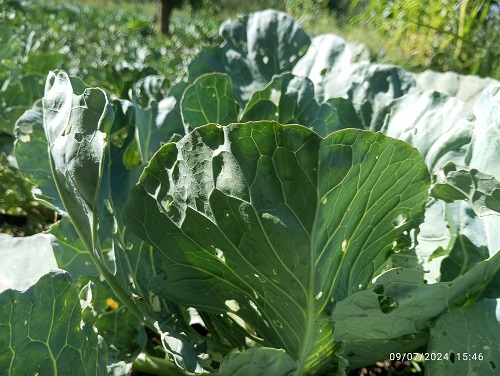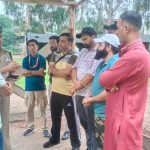Pulwama : Farmers from various areas of South Kashmir’s Pulwama district have been grappling with an unprecedented pest infestation in their Kale crops, describing it as a daunting task to control.
They are now urging concerned authorities for a comprehensive advisory to help them manage such situations in the future.
Waheed Ahmad, a farmer from Drabgam village in Pulwama, shared that this is the first time in the past 20 years he has struggled to control pest infestation in his Kale.
Waheed, who cultivates Kale for commercial purposes on one kanal of land, recounted that while pests have typically affected his Kale crop each year, their populations would usually diminish within a month.
However, this year, the prolonged dry spell and hot weather have allowed pest species to thrive for a much longer duration.
To combat the infestation, Waheed initially experimented with a homemade organic mixture, which proved ineffective. He then resorted to using chemical sprays, including chloropyriphos, which helped bring the pest populations under control but temporarily. Despite these efforts, the pests have started re-emerging, spreading even to newly planted Kale crops, he said.
Fayaz Ahmad, a seasonal commercial vegetable grower from Larebal village in Pulwama, who usually guides fellow farmers, also faced significant challenges this year.
His Kale crop, spread over six kanals, was heavily infested. Fayaz tried using a pesticide typically employed by orchardists in high-density apple orchards against insect infestations, but it proved ineffective. The crop was entirely damaged, and the pests also infected his bean plants.
Fayaz expressed his frustration at being unable to identify the insect species that devastated his kale crop, resulting in substantial economic losses.
Javid Ahmad, another commercial farmer from Wagam village, reported that 80 percent of his kale crop on three kanals of land was damaged by the infestation. This was his first experience dealing with such a severe pest problem.
Javid used an insecticide meant for controlling common houseflies, which failed to yield results. He then attempted using another chemical, cyclone, but his crop was still heavily damaged by the pests, leading to significant financial losses.
The farmers described the pests as small, green-coloured insects that were often found hanging from the lower leaf surfaces of the kale plants. They have called on the concerned authorities to issue an appropriate advisory to help them manage such situations in the future.
“We are facing the impact of climate change, and it is essential to have advanced advisories issued for farmers so that we can adjust our practices accordingly,” Javid said, adding that agricultural officials had failed to help them contain the pest infestation effectively.
Chowdhry Mohammad Iqbal, Director of Agriculture Production and Farmers Welfare Kashmir, was unavailable for comment due to his participation in a meeting.
However, the Vice Chancellor of SKUAST-K, Dr Nazir Ahmad Ganai acknowledged that vegetables like kale (locally known as haakh) were infested with aphids this year.
He attributed the high infestation to climate change and mentioned that a leaflet on aphid management had been disseminated through various social media channels.
The Vice Chancellor assured that a detailed advisory would be released in the coming days to assist farmers in dealing with such issues more effectively.
‘Daunting Task’: Pulwama farmers’ on pest infestation control in Kale

Leave a Comment Leave a Comment







